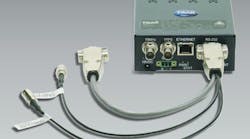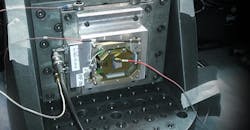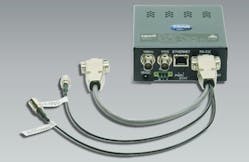Vibration is an environmental reality for almost every defense electronics system. In a radar system—such as a Doppler radar, in which measurements of changes in the frequencies of pulses reflected from a target provide information about the speed and direction of a target—frequency accuracy and stability are essential. Unfortunately, unless vibration is accounted for, it can increase the phase noise within a radar system. The phase noise may be affected by vibration within the receiver’s time-keeping crystal reference oscillator, or else in the circuitry, systems, and environment around that oscillator. This can cause extremely short shifts in phase within the oscillator which can degrade the receiver’s frequency measurements.
A recent blog post from TRAK Microwave Corp. (now Smiths Interconnect), “Mitigating Phase Noise from Vibration in Air Traffic Control and EW Radar Systems,” explored the causes of phase noise in high-frequency oscillators, such as the reference clock oscillators used in different types of radar systems (Fig. 1). It compared the spectral purity of an oscillator or resonator circuit in static environments to those operating in high-vibration environments, pointing out that the vibration-induced phase noise can be orders of magnitude higher than the phase noise in a static environment. Or course, truly static operating environments may exist in a measurement laboratory, but rarely so under tactical conditions, requiring that crystal reference oscillators be designed and constructed for minimal effects of vibration on phase noise.
The blog reveals the significance of increased phase noise on Doppler radar system performance, using an S-band airport surveillance radar as an example. For that system tracking a target at 100 mph, measurements at 3 GHz require low phase noise at 100 Hz from the carrier to avoid a roughly 10% tracking error. For an X-band radar at 10 GHz tracking a jet plane at Mach 1.5, increased phase noise 1 kHz from the carrier can result in target location errors of tens of miles.
Low phase noise is desirable in a crystal oscillator but not always possible to achieve, especially when a radar system may be operating in a high-vibration environment. Fortunately, through the proper choice of materials for the oscillator circuitry and for the enclosure, the effects of vibration can be minimized. Components within a packaged oscillator or resonator can be placed in such a way so that out-of-phase responses cancel either other.
Advanced design and construction techniques were applied in the 8835 GPS clock (Fig. 2) from TRAK for stable operating under high vibration. The clock can be supplied based on a 10-MHz rubidium oscillator or oven-controlled crystal oscillator (OCXO). Outputs include 1 pulse per second (pps), 5 MHz, and 10 MHz signals. It achieves frequency accuracy of better than 1 × 10−12, within 50 ns RMS accuracy to universal time code (UTC). The phase noise for a 10-MHz OCXO is −135 dBc/Hz offset 100 Hz from the carrier, −145 dBc/Hz offset 1 kHz from the carrier, and −150 dBc/Hz offset 10 kHz from the carrier. It employs a proprietary oscillator steering discipline algorithm to enhance the RMS accuracy even under high vibration, and is well suited for defense, satellite communications (satcom) systems, and commercial wireless systems.



